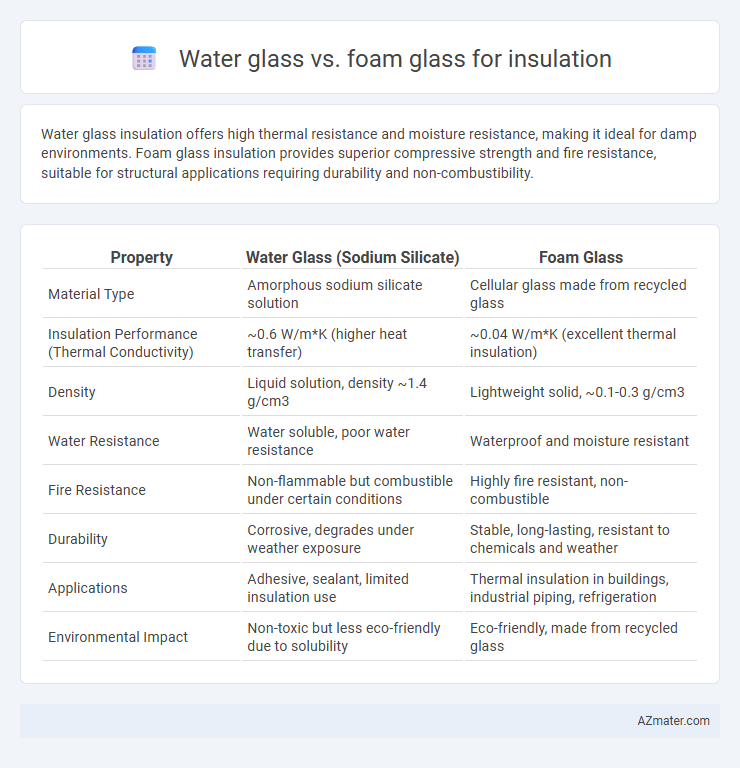Water glass insulation offers high thermal resistance and moisture resistance, making it ideal for damp environments. Foam glass insulation provides superior compressive strength and fire resistance, suitable for structural applications requiring durability and non-combustibility.
Table of Comparison
| Property | Water Glass (Sodium Silicate) | Foam Glass |
|---|---|---|
| Material Type | Amorphous sodium silicate solution | Cellular glass made from recycled glass |
| Insulation Performance (Thermal Conductivity) | ~0.6 W/m*K (higher heat transfer) | ~0.04 W/m*K (excellent thermal insulation) |
| Density | Liquid solution, density ~1.4 g/cm3 | Lightweight solid, ~0.1-0.3 g/cm3 |
| Water Resistance | Water soluble, poor water resistance | Waterproof and moisture resistant |
| Fire Resistance | Non-flammable but combustible under certain conditions | Highly fire resistant, non-combustible |
| Durability | Corrosive, degrades under weather exposure | Stable, long-lasting, resistant to chemicals and weather |
| Applications | Adhesive, sealant, limited insulation use | Thermal insulation in buildings, industrial piping, refrigeration |
| Environmental Impact | Non-toxic but less eco-friendly due to solubility | Eco-friendly, made from recycled glass |
Introduction: The Role of Insulation in Modern Construction
Insulation materials such as water glass and foam glass play a critical role in enhancing energy efficiency and thermal regulation in modern construction. Water glass, a silica-based solution, provides a cost-effective, moisture-resistant barrier, while foam glass offers superior durability, fire resistance, and compressive strength due to its closed-cell structure. Choosing between water glass and foam glass depends on specific project requirements, including thermal performance, environmental impact, and budget constraints.
What is Water Glass? Composition and Properties
Water glass, also known as sodium silicate, is a compound composed primarily of silica (SiO2) and sodium oxide (Na2O), forming a glassy, water-soluble substance used in various industrial and insulation applications. Its key properties include high heat resistance, adhesive qualities, and impermeability to gases and liquids, making it suitable for fireproofing and sealing. In insulation, water glass functions as a binder or protective coating, contrasting with foam glass, which is a lightweight, cellular glass material known for superior thermal insulation and moisture resistance.
Foam Glass Explained: Manufacturing and Key Features
Foam glass insulation is produced by heating crushed glass mixed with a foaming agent, resulting in a lightweight, porous material with excellent thermal and acoustic insulation properties. This non-combustible foam glass offers superior moisture resistance, compressive strength, and durability compared to water glass, making it ideal for industrial and building applications. Its closed-cell structure enhances resistance to chemicals and fire, ensuring long-term stability and energy efficiency in insulation projects.
Comparative Thermal Performance: Water Glass vs. Foam Glass
Foam glass insulation exhibits superior thermal performance with a lower thermal conductivity typically around 0.038-0.040 W/m*K, compared to water glass which generally ranges from 0.05 to 0.07 W/m*K. Foam glass's closed-cell structure provides enhanced resistance to moisture and thermal bridging, resulting in consistent insulation properties over time. Water glass insulation, while cost-effective and easy to apply, tends to have higher thermal conductivity and reduced durability under prolonged thermal stress and moisture exposure.
Moisture Resistance and Durability in Both Materials
Water glass insulation exhibits moderate moisture resistance but can absorb water over time, potentially reducing its insulating properties and durability. Foam glass insulation offers superior moisture resistance due to its closed-cell structure, preventing water infiltration and maintaining long-term thermal performance. Durability in foam glass surpasses water glass as it resists mechanical damage, chemical degradation, and retains structural integrity in harsh environments.
Environmental Impact: Sustainability and Recyclability
Water glass insulation, made from sodium silicate, offers moderate environmental benefits with its recyclability and low production energy, but it often contains additives that may affect biodegradability. Foam glass insulation, produced by recycling crushed glass into a cellular structure, excels in sustainability by using post-consumer glass waste and providing long-term durability without off-gassing harmful substances. The recyclability of foam glass is superior, as it can be crushed and reused multiple times, making it a more eco-friendly option compared to water glass in reducing landfill waste and lowering carbon footprint.
Fire Resistance: Safety Profiles of Water Glass and Foam Glass
Water glass insulation exhibits excellent fire resistance due to its inorganic composition, which prevents combustion and limits the spread of flames. Foam glass, made from crushed glass with closed-cell structures, offers superior fire safety by being non-combustible and maintaining structural integrity under high temperatures. Both materials provide enhanced fire protection, with foam glass excelling in thermal stability and water glass providing reliable fire-retardant properties suitable for various industrial applications.
Installation Methods and Practical Considerations
Water glass insulation typically requires mixing with sand and cement to form a solid, seamless barrier applied as a slurry or spray, making it ideal for irregular surfaces but demanding skilled labor and curing time. Foam glass insulation, supplied in rigid blocks or panels, is installed using mechanical fasteners or adhesives, offering straightforward, quick setup with excellent compressive strength and moisture resistance. Practical considerations favor foam glass for projects needing rapid installation and durability, while water glass suits complex shapes requiring a continuous, vapor-tight layer.
Cost Comparison: Affordability and Lifecycle Value
Water glass insulation generally offers a lower upfront cost compared to foam glass, making it more affordable for initial installation projects. Foam glass insulation, although more expensive initially, provides superior durability and moisture resistance, resulting in lower maintenance and replacement costs over its lifecycle. When evaluating long-term value, foam glass often delivers better cost efficiency due to its extended lifespan and enhanced thermal performance.
Choosing the Right Insulation: Water Glass or Foam Glass?
Water glass insulation offers excellent fire resistance and thermal stability, making it ideal for high-temperature applications, while foam glass excels in compressive strength and moisture resistance, suitable for damp or load-bearing environments. Foam glass, composed of recycled glass, provides superior environmental sustainability and long-term durability compared to water glass, which is more susceptible to chemical degradation. Selecting the right insulation depends on specific project requirements such as thermal performance, exposure to moisture, and structural support needs.

Infographic: Water glass vs Foam glass for Insulation
 azmater.com
azmater.com